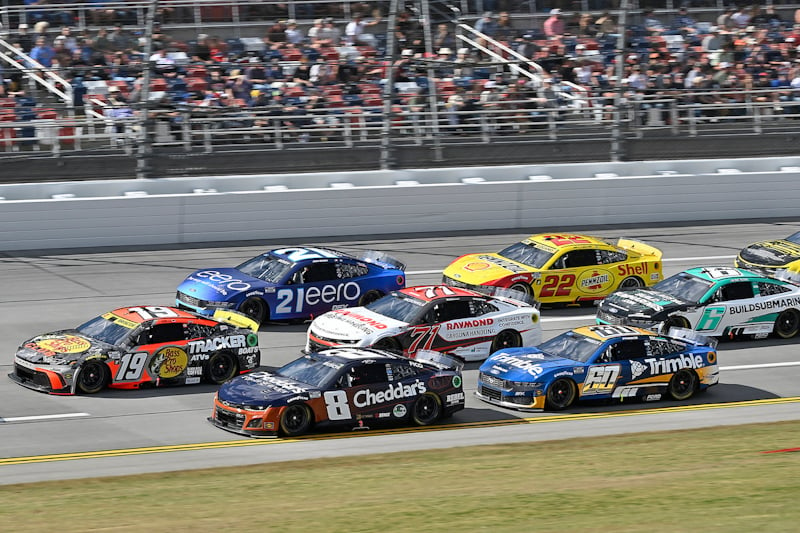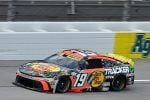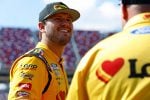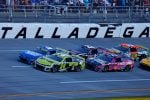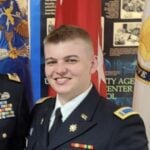What Happened?
Chase Briscoe outdueled playoff rivals and fellow Toyotas alike to win at Talladega Superspeedway on Sunday, Oct. 19. Following behind him was Todd Gilliland, Ty Gibbs, Bubba Wallace and Cole Custer to round out the top five.
With his victory, Briscoe will join his Joe Gibbs Racing teammate Denny Hamlin to race for a NASCAR Cup Series championship at Phoenix Raceway in two weeks.
What Really Happened?
With 30 laps to go, I found myself slumped in my chair watching the final laps of Sunday’s 500-miler at Talladega as the field was three-abreast from the lead on back while listening to the radio scanner that was buzzing with constant spotter chatter. Then, I did something I probably haven’t done in all of my years of watching superspeedway racing.
I yawned.
Then, that caution with 23 laps to go came out, and when everybody came to pit road to top off on fuel for the rest of the event and ran 100% throttle afterward, I wasn’t yawning anymore.
Lead change after lead change, battle after battle, it seemed like the whole field came to life in perfectly orchestrated chaos. That’s what superspeedway racing used to be like. That’s what it’s supposed to be like.
I was glued to the screen once again and on the edge of my seat, not knowing who was going to win.
And to think, it was almost ruined by a fuel-saving race.
It’s a shame that superspeedway racing has become what is considered a dull affair for many NASCAR fans nowadays, but I can understand why.
Like you, I was bored of the constant fuel saving. Drivers pushing at only half-throttle for 40-50 laps at a time isn’t entertaining. While they are doing so at three, and sometimes four, abreast is certainly fascinating, and I will still die on that hill, it can be admittedly dull when there’s nothing at stake.
But Sunday’s final 20 laps showed that this type of racing is fun. However, it feels wrong that we have to wait 171 laps and around three hours to be rewarded with a fun finish.
Does that mean the superspeedway races should be shortened? If that will fix fuel strategies then, sure. I understand there is a tradition for 500 miles being ran at Talladega no matter what. For the most part, I agree.
But what is more likely to be changed first? This brand-new racecar that NASCAR has invested millions of dollars of investment in? Or a hundred miles being taken off at Talladega?
Who Stood Out?
In all honesty, it’s pretty difficult to nail down one specific driver that stood out.
In fact, not one driver led more than 35 laps all day, and the one who led the most finished 16th. We’ll get to him — and a few others — later.
But perhaps a tip of the cap should be given to Kyle Busch. The No. 8 Chevrolet led 26 laps on Sunday afternoon. It was the first time Busch had led a lap since Kansas Speedway in May this year and the most laps he had led at Talladega since 2017.
It has been a rough year for Rowdy, who not long ago in 2023 was coming off of a three-race-winning season. Now, however, it seems KFB nation is looking for any signs of hope that Busch may one day win again. Sunday, for a moment, seemed to be that day.
Even on the final lap while mired in traffic around 11th, the two-time champion received a huge push and tried to make a third lane on the outside. Alas, it didn’t work, and the No. 8 had to settle for 19th.
But make no mistake, today appeared to be a day the future Hall of Famer desperately needed.
Perhaps something similar could be said about the Front Row Motorsports organization or, more specifically, its driver Gilliland.
Both Gilliland and teammate Zane Smith were controlling the top two positions near the end of the race with only 10 laps to go.
Indeed, it appeared like shades of the 2013 spring race at Talladega when Gilliland’s father, David Gilliland, pushed FRM teammate David Ragan to the lead and win.
Unfortunately, with the overtime restart, it didn’t work out the exact same with neither driver winning. That said, like 12 years ago, a Gilliland finished second.
It’s Gilliland’s best career result and only the second top five of his career.
Who Fell Flat?
Where to begin?
Originally, the Team Penske trio of Joey Logano, Ryan Blaney and Josh Berry were going to hold the weekly honor of being those that stood out on Sunday.
And for all intents and purposes, they did. Both Logano and Berry led a combined 62 laps around the Talladega circuit while Blaney led only three but was up front for most of the race playing rear gunner for Logano.
Indeed, it looked like it was going to be every Logano hater’s nightmare scenario as the No. 22, for much of the event, was the favorite to win all the way down to the final 50 laps.
However, for Berry, his hopes ended earlier. The No. 21 had a mechanical issue shortly after the end of the second stage that forced him behind the wall. While he came out again three laps later, he returned to the garage for good with around 50 laps to go. He finished 33rd, continuing a miserable streak of results during this year’s postseason.
Despite Logano and Blaney’s late rally, it was not the day either one of them had hoped for earlier, either. Logano, who was many points below the cut line heading into Sunday, missed out on both stages for points. Blaney, at least, was able to finish third in stage one and seventh in stage two.
The duo was at least in position to gather a great points haul late in the going when they held the top two spots. Unfortunately, shortly after the penultimate restart, both the Nos. 12 and 22 faded through the pack down into the 20s.
Upon the final caution inciting an overtime restart, they both had to pit to top off on fuel, driving them further down the standings with two laps to go.
In the end, Logano could only rally for a 16th-place finish while Blaney ended in 23rd. Both drivers face certain elimination at Martinsville next weekend barring a win.
The same could be said for two of the three remaining Hendrick Motorsports drivers. Chase Elliott wrecked out early in a multi-car crash in stage one and not only couldn’t gather any stage points but also was scored in last place in 40th — his lowest Cup Series race result since his part-time year in 2015 — and is now a massive 62 points below the cut line and in a must-win situation for Martinsville.
Perhaps more heartbreaking was the plight of his teammates Kyle Larson and William Byron. Both HMS cars restarted on the front row for the overtime restart and in position to win themselves into the Championship 4. Alas, Larson ran out of gas on the backstretch while Byron was turned into the infield while coming to the checkered flag. Byron and Larson finished 25th and 26th, respectively.
Despite the unfortunate end, Larson still sits 36 points above the playoff cutline. The bad news is Byron is the one 36 points behind him and below it.
Paint Scheme of the Race
Busch Light has been putting out some great car designs over the last few years dating back to the waning years of Kevin Harvick‘s career.
This weekend with Ross Chastain was no different, but it’s still a shame that nobody could see it.
Jokes aside, camouflage has never been one of my favorite patterns. However, the orange-highlighted number and secondary color gives what is normally a dull and murky look a more vibrant design that makes it pop out a bit more.
Kind of defeats the purpose of camouflage, doesn’t it?
What’s Next?
The penultimate race of the season at one of the ultimate short tracks.
This year’s playoff Round of 8 comes to an end at Martinsville Speedway where all three of NASCAR’s national series will set their Championship 4 drivers.
Race 35 out of 36 for the Cup Series in 2025 will be broadcast live on NBC with coverage beginning at 2 p.m. ET on Sunday, Oct. 26.
Dalton Hopkins began writing for Frontstretch in April 2021. Currently, he is the lead writer for the weekly Thinkin' Out Loud column, co-host of the Frontstretch Happy Hour podcast, and one of our lead reporters. Beforehand, he wrote for IMSA shortly after graduating from Embry-Riddle Aeronautical University in 2019. Simultaneously, he also serves as a Captain in the US Army.
Follow Dalton on Twitter @PitLaneCPT

